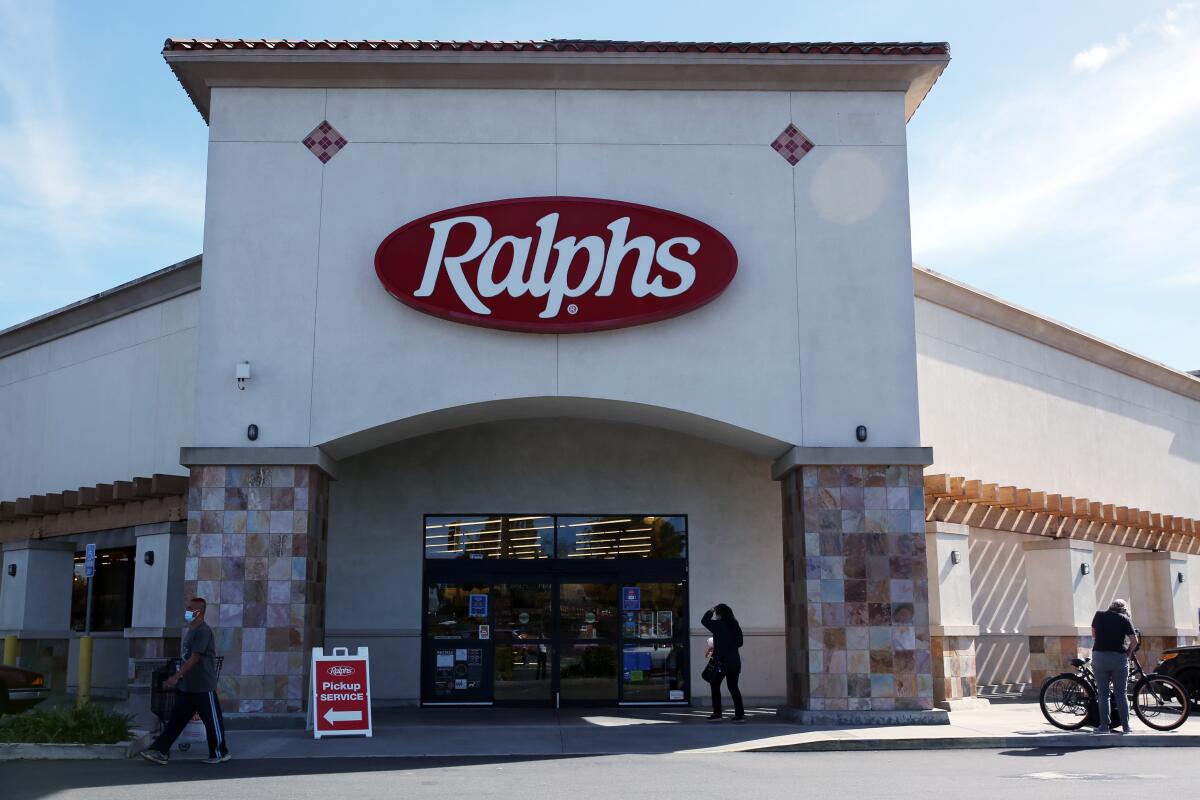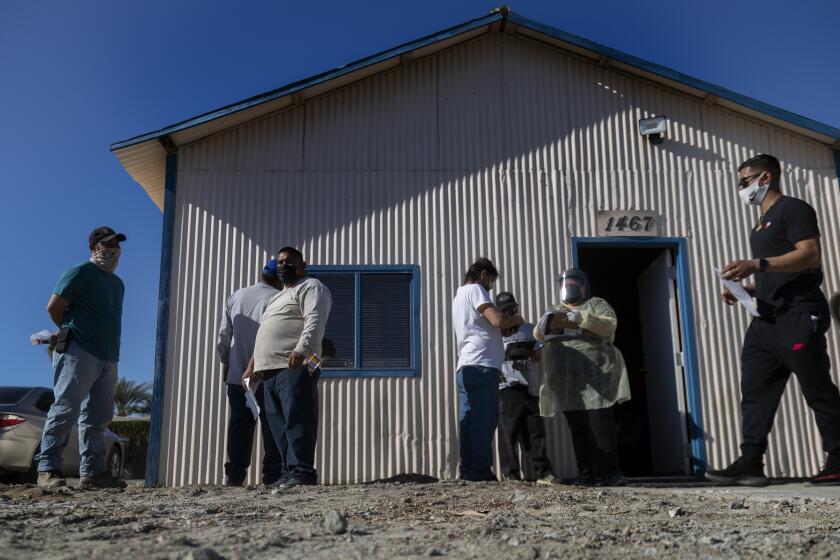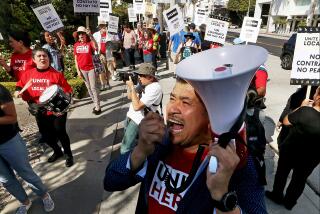L.A. County supports grocery âhero pay,â while city report warns of potential layoffs

Los Angeles County approved a $5 an hour pay hike for grocery store workers Tuesday, the same day that Los Angeles moved forward a similar proposal, despite warnings from its financial analysts that grocery chains may lay off workers and close stores.
The L.A. County Board of Supervisors voted 4 to 1 to mandate the hazard pay increase for publicly traded and larger private grocery store or retail drug companies, benefiting about 2,500 hourly grocery store workers in unincorporated parts of the county.
The county joins other jurisdictions, including Santa Monica, San Jose, Berkeley, Long Beach and West Hollywood that have considered or passed some level of so-called hero pay mandates. United Food and Commercial Workers International, which represents 1.3 million workers in grocery, meatpacking and other front-line industries, is spearheading the push to increase pay.
The grocery store industry has responded by shutting down stores and suing cities that have passed similar ordinances. The giant Kroger chain announced plans to shutter two stores in Long Beach after that city moved to require stores to pay workers an extra $4 an hour.
Ron Fong, president and chief executive at the California Grocers Assn., which represents more than 300 retailers operating more than 6,000 stores, said he expected his group to sue the county. âThatâs just unfortunate,â Fong said.
The Los Angeles City Council is also poised to vote Wednesday on an ordinance requiring a $5 boost for more than 26,000 grocery and retail drug store workers. On Tuesday, a City Council committee voted to support the ordinance, despite a new city report that raises questions about how grocery chains would shoulder the additional cost.
In a Feb. 19 report, Chief Legislative Analyst Sharon Tso wrote that the grocery industry is a low profit-margin industry and that the net profit margins of Kroger (which owns Ralphs and Food 4 Less) and Albertsons Cos. (owner of Vons, Pavilions and others) were near or below the industry average of 2.2% in 2019.
By comparison, companies that trade in the Standard & Poor 500 index saw an average net profit margin of 14% in 2019, a city analyst told council members at the council committee meeting Tuesday.
Here is what to expect in the coming weeks, along with some information about Californiaâs $600 COVID relief benefit.
Net profit margin is a measure of earnings as a percentage of revenue, according to the report.
The cityâs analysis suggests that a spike in sales from people stockpiling groceries in the early months of the COVID-19 pandemic was temporary and didnât translate into a profitability trend for stores.
Kroger and Albertsons saw big boosts in early 2020, the report found. Still, the âcompanies did not earn above-average profits until the first quarter of 2020 during the COVID-19 shopping spike and by the third quarter had dropped below the average,â the report found.
Grocery store chainsâ big gains during the pandemic has been cited by some L.A. city leaders as a reason to force them to hike pay for their workers. A widely cited report by the Brookings Institution studied the profits of the three largest grocery providers â Walmart, Kroger and Albertsons, and found that together they earned an additional $6.8 billion in profit in the first three quarters of 2020 compared with 2019 â an average increase of 98%.
Tsoâs report also looked at private grocery store chains, finding the average net profit before taxes was 1.85% for independent grocers for the five years before the pandemic. âAfter the March 2020 surge, the number of trips to stores fell well below 2019 levels as shoppers quarantined at home,â the report states.
The city report found the $5-per-hour boost would increase the average pay of workers to $22.51 per hour, an increase of 29% from the base wage, according to the city report.
âEmployees would have a temporary earnings boost and more spending power, which could trigger a temporary increase in the demand for goods,â the report notes.
At the same time, grocery stores could raise food prices in response close stores, cut employeesâ pay or lay them off, the report says.
The city report states that more profitable grocery stores often subsidize unprofitable stores within the same chain and âsmaller chains with fewer stores will have less capacity to rely on their profitable stores to make up the increase in labor costs.â
A UC Berkeley IGS poll released Tuesday also found that people of color, especially Latinos and Native Americans, were hit hard by the COVID-19 pandemic.
The city report included information about the âestimated excess mortality of Californiansâ by their job category during the pandemic, stating that food and agricultural workers saw the highest rates of death. The report characterized Latino and Black workers as having high rates of mortality.
Retailers will probably try to absorb the costs because they have to remain competitive, but they could close underperforming stores, which could include locations in smaller suburbs, low-income neighborhoods with high numbers of dollar stores, and in rural areas, said Neil Saunders, a retail analyst at GlobalData.
âOr it could be a particularly weak or older store in a vibrant neighborhood where newer and better retailers have opened there,â Saunders said.
Saunders said grocers have found, especially during the pandemic, that although grocery delivery has grown in popularity, higher labor and transportation costs make the service unprofitable.
âIf you keep messing around with pay, the grocers will start to say âOK, letâs see where we can cut labor out,â â Saunders said, adding that Kroger has starting testing stores that do not have registers and instead are self-service only.
Some worry about a patchwork of âhero payâ mandates sprouting up across L.A. County.
The countyâs ordinance applies only to unincorporated areas, which includes portions of South L.A. and much of northern L.A. County. Many of the 88 cities in the county do not have such measures, meaning a worker can live in one city with a mandate but work in another without it.
As government restrictions and fear around eating at restaurants declines, people will return to their old eating habits, said Burt P. Flickinger III, manager director at Strategic Resource Group, a retail and consumer goods consulting firm.
Grocery sales âwill drop significantly, and with sales dropping significantly, the operating profit per store per property will drop significantly as well,â he said.
This could lead some retailers to close underperforming stores to make up for the cost of hero pay.
At Tuesdayâs county board meeting, Supervisor Kathryn Barger was the only supervisor to vote against the measure. She said officials have worked hard to bring retailers to food deserts in unincorporated areas, such as Grocery Outlet in Altadena, which has donated food for food drives during the pandemic.
âI would hate to think weâre driving [out of business] the very businesses we fought so hard to locate in unincorporated areas, many of which are working-class neighborhoods ... and thatâs why I canât vote for this,â Barger said.
Times staff writer Ruben Vives contributed to this report.
More to Read
Sign up for Essential California
The most important California stories and recommendations in your inbox every morning.
You may occasionally receive promotional content from the Los Angeles Times.













